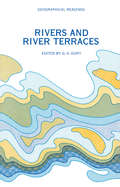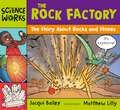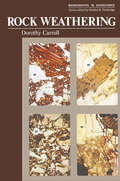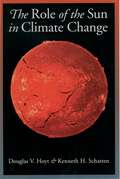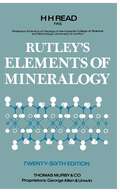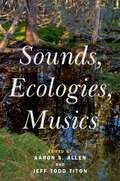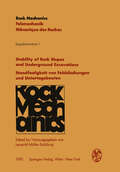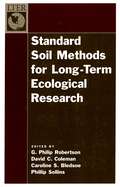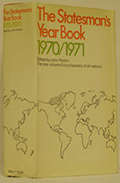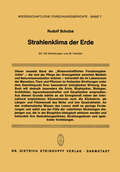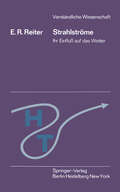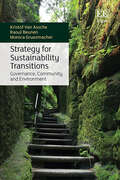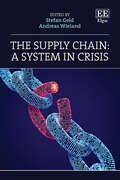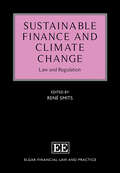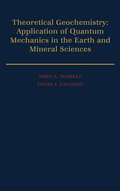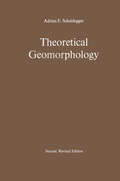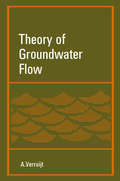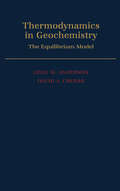- Table View
- List View
The Rock Factory: A Story about Rocks and Stones (Science Works)
by Ms Jacqui BaileyA brand new edition of The Rock Factory from the Science Works series, featuring lively storytelling and fun, engaging illustrations to aid children in their learning.Deep down underground the Earth's rock factory is mixing and melting, and squeezing and stirring, and baking and making rocks.In this revised edition from Jacqui Bailey, The Rock Factory tells the story of how a special sort of stone formed deep inside the Earth, and came to the surface thousands of millions of years later. The Rock Factory looks at how minerals turn into rock crystals, how the Earth is structured and how volcanoes happen. This book also contains an experiment, useful websites and an index.Book band: LimeIdeal for KS2.
Rock Weathering (Monographs in Geoscience)
by Dorothy CarrollSoil science is perhaps one of the oldest practical sciences, having been of concern to man probably from the time he progressed from a strictly preda tory life to one in which agriculture became important. In view of the anti quity of concern with the subject, it is perhaps surprising that it can be approached from a fresh viewpoint, as is done in this book. Because soil science is an applied science, it is not surprising that the approach is usually descriptive, rather than imaginative. For agriculturalists and other land users, perhaps the most important part of soil science is the description of soils and the capacities of such soils to maintain crops, and this is reflected by the fact that soil science is usually treated ima highly descriptive manner, with soil classification being one of the main efforts. The treatment of the subject from a geological point of view, with considerable emphasis on the evolution of soils and the reasons governing their composition and form, makes this a highly readable book. Books on soil science are timely, with present-day concern with such major problems as the pollution of our environment and the possibility of overreaching our capacity for producing food for an expanding population.
The Role Of The Sun In Climate Change
by Douglas V. Hoyt Kenneth H. SchattenThe luminosity of the sun governs the temperatures of the planets. Yet the solar forcing, or driving, of climate, primarily due to changes in solar radiation, has never been well documented. Recent satellite measurements have shown that solar radiation varies as a function of time andwavelength, a concept that has been hypothesized for the past two centuries and has recently become a major topic with all the attention paid to global warming. This book reviews the physics of the concept of solar forcing, from its beginnings in the early 1800's and apparent success in the 1870's, to its near demise in the 1950's and recent resurgence. Since its emphasis is on solar variations as a driver for climate change, with only a brief discussion of other mechanisms, the book will be of most interest to students in climate studies.
Rutley’s Elements of Mineralogy
by Frank RutleyThe last thorough revision of Rutley's Elements of Mineralogy appeared as the 23rd Edition in 1936. In subsequent editions, an effort to keep abreast with the great progress in the science was made by small (and often awkward) modifications and, especially, by the addition of an independent chapter on the atomic structure of minerals. For this present edition, the complete re-setting of the book has made possible not only the integration of the added chapter on atomic structure into its proper place in the accounts of the chemical and physical properties of minerals, but also extensive rewriting and rearrangement of the material in the first part of the book. To this part, also, has been added a short chapter on the classification of minerals. In the second part, the Descrip tion of Minerals, numerous, if not so extensive, modifications and modernisations have been introduced. A couple of dozen new figures have been added, mostly in the early part of the book. More specifically, the major changes in this new edition are the following. The electronic structure of atoms supplies the guide lines for the whole account of mineral-chemistry; additional items concern the electrochemical series, of interest in the occurrence and metallurgical treatment of ores, and chemical analysis. On the physical side, the dependence of physical properties of minerals on their atomic structure is emphasized and, in addition, a brief account of radioactivity and isotopic age-determination is given.
Scotland's Mountain Landscapes: A Geomorphological Perspective
by Colin K. BallantyneThe diversity of Scotland's mountains is remarkable, encompassing the isolated summits of the far northwest, the serrated ridges of Skye, the tor-studded high plateau of the Cairngorms and the rolling hills of the Southern Uplands. Born on ancient continents and uplifted by tectonic forces, the mountains of Scotland have been sculpted by successive ice sheets, landslides, frost, wind and running water. This book explains the geological evolution of Scotland's mountains, and how this has produced an unparalleled variety of mountain forms. It outlines the effects of successive ice sheets on mountain scenery, and explains the dramatic changes in climate that terminated the Ice Age only 11,500 years ago. In non-technical terms it explains the effects of frost action in forming the rubble that mantles many mountain summits, and how such debris has slowly migrated downslope by freezing and thawing of the ground. The dramatic effects of deglaciation and earthquakes in triggering catastrophic landslides and downslope displacement of entire mountainsides are described, along with accounts of more recent events involving the rapid downslope flow of saturated debris. The book also outlines how Scottish mountains experience frequent gale-force winds, and their impact of wind in scouring plateaus and depositing expanses of windblown sand on lee slopes. The role of floods in eroding upland terrain and depositing floodplains, terraces and fans of sediment is described in the context of possible human influence on river regime through forest clearance.Written in clear, non-technical language and abundantly illustrated, this book is designed to provide an essential guide to landforms for all those who walk, climb, live and work in the mountains of Scotland.
Sedimentary Structures
by John Collinson Nigel MountneyNow enhanced with colour photographs and illustrations, this thoroughly revised fourth edition of Sedimentary Structures enhances its status as a major textbook in geology. Since its first publication in 1982, Sedimentary Structures has established and maintained itself as a pre-eminent resource that sets out a clear methodology and philosophy for understanding present-day sediments and sedimentary rocks as the product of dynamic processes.The fourth edition of this classic textbook introduces erosional, depositional and post-depositional sedimentary processes in an easily accessible way. It shows how sedimentary structures can be interpreted, across a wide range of scales, in terms of those processes.Sedimentary structures produced by erosion, deposition and post-depositional change are all clearly explained and related to the processes that formed them. Hydrodynamic and aerodynamic controls on the development of subaqueous and aeolian bedforms are discussed, as are the styles of deformation to which sediments can be subjected after deposition. Structures that characterize deposition caused by chemical and biologically influenced processes are explained and illustrated, along with the complex effects of chemical changes, and of animal and plant activity in modifying sediments after they have been deposited. The book ends with an introduction to the methods and principles of environmental interpretation, for which earlier chapters provide an invaluable basis.Sedimentary Structures is designed principally for use in undergraduate settings and will be invaluable to students reading geology, earth sciences, physical geography and environmental sciences throughout their degree studies. It will also appeal to enthusiastic students at colleges and schools, as well as to amateur geologists who want to gain an understanding of sedimentary processes and products. Furthermore, the book is also valuable as a reference for both academic researchers and industry professionals alike. The fourth edition covers all major recent developments in the subject. It is characterized by an abundance of informative illustrations and photographic examples, and introduces colour figures for the first time.This edition, the first prepared without the direct input of the late David Thompson, builds on a major re-write that paid particular attention to recent advances in the understanding of aeolian processes and bedforms, and in the interpretation of trace fossils. The introduction to environmental interpretation has been further developed to reflect recent advances in stratigraphic thinking, thereby enabling sedimentologists to more readily relate the occurrence of assemblages of sedimentary structures to likely environments of deposition. Sedimentary Structures emphasizes a practical, hands-on approach. It remains indispensable to those with a serious interest in the study of sedimentary structures, not only as fascinating features in themselves but also as key indicators in the reconstruction of past environments.
Sounds, Ecologies, Musics
Sounds, Ecologies, Musics poses exciting challenges and provides fresh opportunities for scholars, scientists, environmental activists, musicians, and listeners to consider music and sound from ecological standpoints. Authors in Part I examine the natural and built environment and how music and sound are woven into it, how the environment enables music and sound, and how the natural and cultural production of music and sound in turn impact the environment. In Part II, contributors consider music and sound in relation to ecological knowledges that appear to conflict with, yet may be viewed as complementary to, Western science: traditional and Indigenous ecological and environmental knowledges. Part III features multidisciplinary and interdisciplinary approaches by scholars, scientists, and practitioners who probe the ecological imaginary regarding the complex ideas and contested keywords that characterize ecomusicology: sound, music, culture, society, environment, and nature. A common theme across the book is the idea of diverse ecologies. Once confined to the natural sciences, the word "ecology" is common today in the social sciences, humanities, and arts - yet its diverse uses have become imprecise and confusing. Engaging the conflicting and complementary meanings of "ecology" requires embracing a both/and approach. Diverse ecologies are illustrated in the methodological, terminological, and topical variety of the chapters as well as the contributors' choice of sources and their disciplinary backgrounds. In times of mounting human and planetary crises, Sounds, Ecologies, Musics challenges disciplinarity and broadens the interdisciplinary field of ecomusicologies. These theoretical and practical studies expand sonic, scholarly, and political activism from the diversity-equity-inclusion agenda of social justice to embrace the more diverse and inclusive agenda of ecocentric ecojustice.
Stability of Rock Slopes and Underground Excavations / Standfestigkeit von Felsböschungen und Untertagebauten: Contributions to the Josef-Stini-Colloquium (18th Geomechanical Colloquium) of the Austrian Society for Geomechanics / Vorträge des Josef-Stini-Kolloquiums (18. Geomechanik-Kolloquium) der Österreichischen Gesellschaft für Geomechanik (Rock Mechanics Felsmechanik Mecanique des roches. Supplementa #1)
by Leopold MüllerStandard Soil Methods For Long-term Ecological Research
by G. Philip Robertson David C. Coleman Caroline S. Bledsoe Phillip SollinsThe Statesman's Year-Book 1970-71: The one-volume Encyclopaedia of all nations (The Statesman's Yearbook)
by J. PaxtonThe classic reference work that provides annually updated information on the countries of the world.
Strahlenklima der Erde (Wissenschaftliche Forschungsberichte #72)
by Rudolf Schulze(Wissenschaftliche Forschungsberichte, Reihe I, Abt. B., Band 72)
Strategy for Sustainability Transitions: Governance, Community and Environment
by Kristof Van Assche Raoul Beunen Monica GruezmacherIn this innovative work, Kristof Van Assche, Raoul Beunen and Monica Gruezmacher analyse the challenges and possibilities of sustainability transitions, presenting the dilemmas facing the path to more sustainable communities and societies, as well as proposing creative solutions. The authors deploy evolutionary governance theory as a conceptual framing for transition strategy, highlighting the importance of understanding governance and community strategy in any potential response to environmental crises.This timely book expertly draws on a wide range of disciplines and theories, in considering the limitations imposed by unpredictable dynamics of power, discourse and affect and the shifting boundaries of what is governable. The authors demonstrate the creative potential of both instabilities and rigidities in governance. Chapters detail the basics of evolutionary governance theory, developing and applying it to transition strategy by engaging in an accessible manner with post-structuralism, psychoanalysis, institutional economics, systems theory and critical management studies. In a clearly constructed theoretical narrative, the results of this engagement become clear, in a new understanding of the weight of the past on governance and community, the construction of temporality, change and strategic change, contextual notions of good governance, and how these affect major shifts towards sustainability.Strategy for Sustainability Transitions is an important addition to an ever-expanding and crucial field. Particularly relevant to practitioners and policy makers interested in sustainable development and environmental governance, it will greatly appeal to students and scholars of human geography, public policy and administration, environmental politics and planning and development studies.
The Supply Chain: A System in Crisis
The Supply Chain: A System in Crisis highlights the multifaceted challenges facing modern supply chains. It examines the concept of a globalized economy, juxtaposing the promise of prosperity with the acute reality of worker exploitation and environmental harm. This thought-provoking book explores the interconnected relationships of supply chains with political problems, social crises, and the depreciation of natural resources.Analyzing in depth the rapid development of the global economic system and the subsequent vulnerability of the supply chain, international experts dive into the many issues exacerbated by this commercial evolution, covering disasters such as the Rana Plaza collapse. Urging the reader to rethink supply chain management, the book calls for a transformation from mere value creation to sustainability and regeneration. Considering the power of systemic and holistic thinking as well as transformative public policy, it envisions a future in which supply chains emerge reborn and resilient.This seminal book is an indispensable resource for scholars of supply chain and sustainability management, corporate social responsibility, and responsible consumption and production. It will also be of critical use to practitioners, political decision makers, business strategists, and environmental and labor rights activists.
Sustainable Finance and Climate Change: Law and Regulation (Elgar Financial Law and Practice series)
Sustainable Finance and Climate Change explores the legal and regulatory framework that governs the transition to a carbon free economy, looking in particular at the regulation of the financial sector and corporate liability for climate change and biodiversity loss. In addition, it looks at the effect on general corporate law, environmental law, central bank law, as well as litigation and arbitration.Key Features:Discussion of the duty of societal responsibility in the context of corporate governancePractical analysis of arbitration and litigation in the resolution of climate change-related disputesExploration of the role of investors in the new sustainable finance-related regulatory frameworkComprehensive examination of sustainable finance in South AfricaIn-depth analysis of the role of law and regulation in providing sustainable finance by means of various financial modalitiesEvaluation of the newly-established framework in the EU, including the Climate Law, the taxonomy and the role of the ECB as a monetary and supervisory authorityThis important book will be a key resource for practitioners specialising in financial services, environmental law and dispute resolution, and will also appeal to scholars in these fields.
Termites and heritage buildings: A study in integrated pest management
by Brian RidoutThe last overview of termites for the non-specialist was published several decades ago and in the intervening years, both knowledge, and the termites themselves have moved on. A 27-year eradication effort for one termite infestation in Devon has shown that UK structures are becoming vulnerable as the climate changes and also that extermination of a colony can be difficult even when there are no other termites waiting to invade. Heritage buildings often present even more problems. Survey work and treatments may be complicated by structural and material complexity overlain with a requirement to retain as much undisturbed and original fabric as possible. There will be concealed cavities not inspected, and inserted barriers, both chemical and physical, will inevitably be incomplete. This study discusses the modifiable environmental parameters that govern termite activity and offers a resume of the baits and chemical treatments that have been developed so that the most appropriate can be selected where necessary. It is primarily intended for those involved in conservation, both in the UK and elsewhere, who commonly have limited resources. It is hoped that it will also be of use to architects, surveyors and others with an interest in Heritage structures.
Terrestrial Conservation Lagerstatten: Windows into the Evolution of Life on Land
by Nicholas Fraser Hans-Dieter SuessEvolutionary biologists have long been concerned by the incompleteness of the fossil record. Although our knowledge of the diversity of life in ‘deep time’ has improved, many lineages of extant animals and plants still have only sparse fossil documentation. Even groups with ‘hard parts’ that render them suitable for fossilization often only have a limited record. Thus, although the fossil record is viewed as critical to the reconstruction of the evolutionary history of life, many biologists question its utility. Fortunately discoveries of occurrences of exceptionally preserved fossils, known as conservation Lagerstätten (Konservat-Lagerstätten), shed much light on the past diversity of life. This volume reviews selected conservation Lagerstätten for terrestrial animals and plants throughout the Phanerozoic worldwide and includes sites in Asia, Europe and North and South America. Together the papers demonstrate the enormous progress made in recent years both in documenting the biodiversity of such extraordinary fossil deposits and also in elucidating the geological conditions for and biogeochemical processes behind the formation of conservation Lagerstätten. Each contribution has been written by eminent palaeontologists who have enlisted additional expertise to make each chapter as comprehensive as possible.N.B. Some corrections are available to this book and may be obtained from the publisher
Theoretical Geochemistry: Applications Of Quantum Mechanics In The Earth And Mineral Sciences
by John A. Tossell David J. VaughanTheoretical Geomorphology
by Adrian E. ScheideggerThe surface features of the Earth are commonly split into two cate gories, the first of which comprises those features that are due to processes occurring inside the solid Earth (endogenetic features) and the second those that are due to processes occurring outside the solid Earth (exogenetic features). Specifically, the endogenetic features are treated in the science of geodynamics, the exogenetic features in the science of geomorphology. I have treated the theoretical aspects of the endogenetic features in my "Principles of Geodynamics", and it is my aim to supplement my earlier book with a discussion of the theory of the exogenetic features. It is my hope that the two books will together present a reasonably coherent, if necessarily incomplete, account of theoretical geology. Contrary to endogenetic phenomena, exogenetic processes can often be directly observed as they occur: the action of a river, the development of a slope and the evolution of a shore platform are all sufficiently rapid so that they can be seen as they take place. This has the result that in geomorphology one is generally on much less speculative ground regard ing the mechanics of the processes at work than one is in geodynamics.
